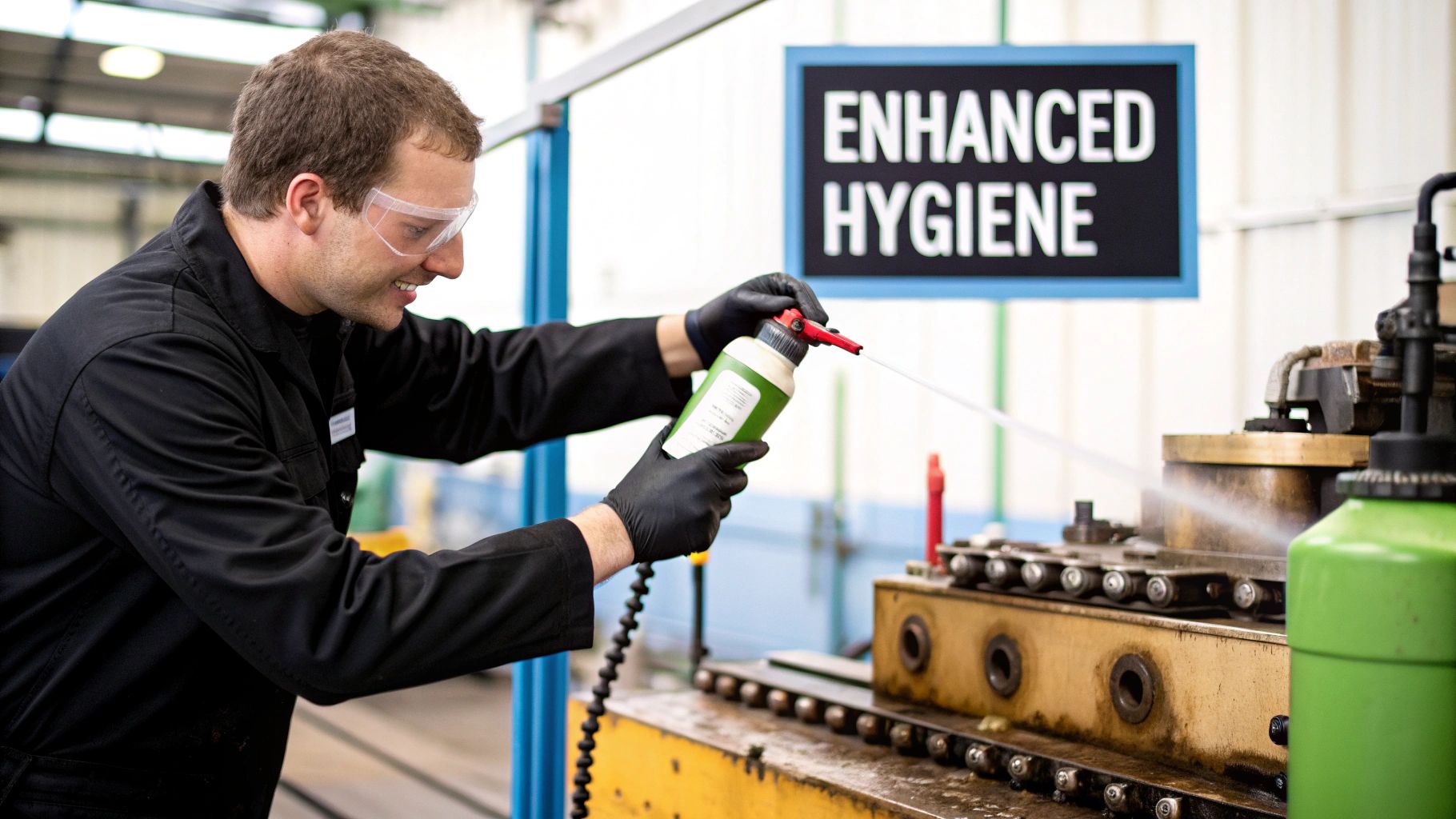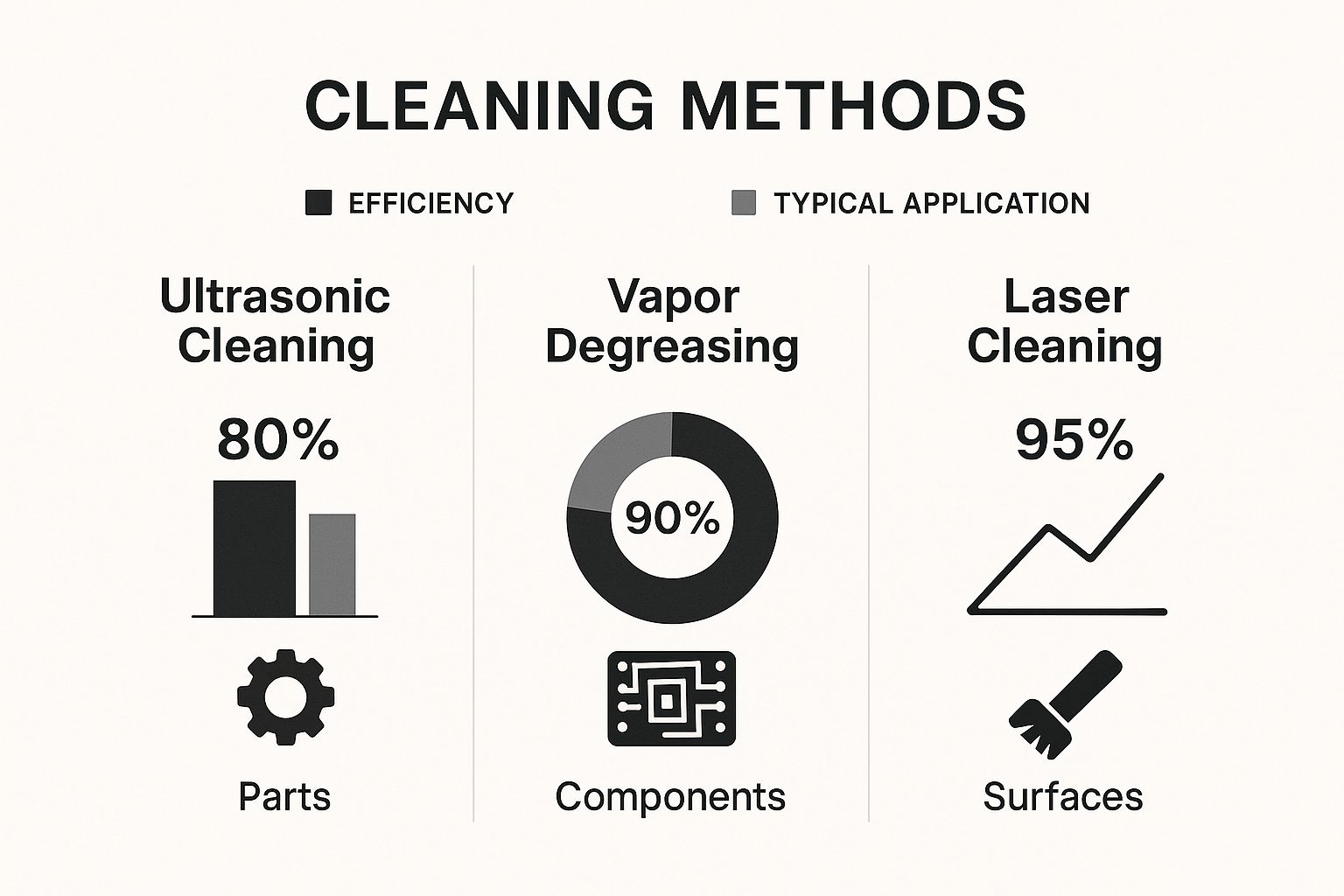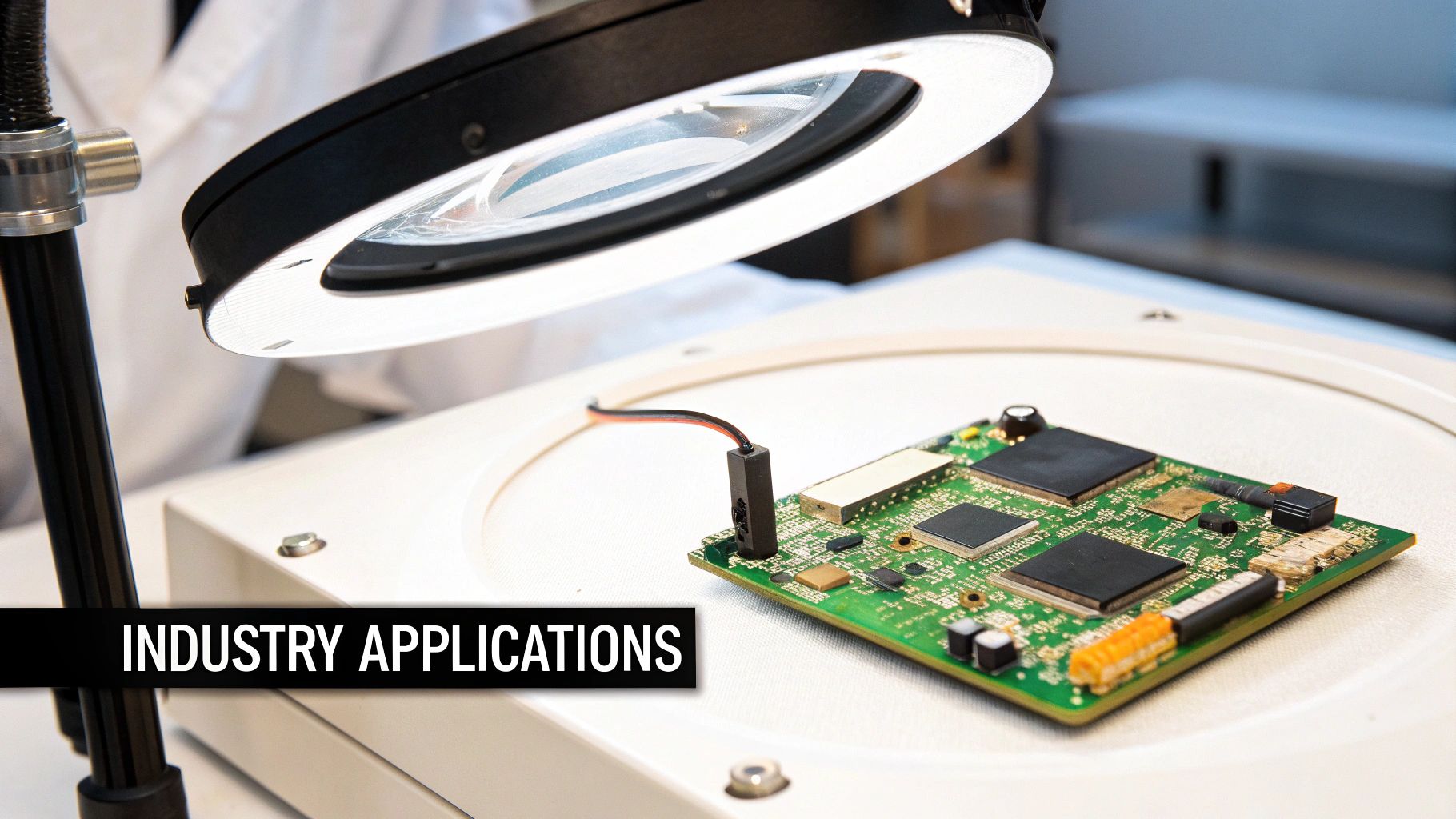Top Precision Cleaning Services for High-Tech Industries in California
- Laserverse

- May 19
- 10 min read
The Science Behind Precision Cleaning: Why It Matters
Precision cleaning services are more than just making things appear clean. They involve controlling contamination at the microscopic level. This is particularly important in California's thriving technology sector, where even invisible particles can have significant consequences. For instance, in semiconductor manufacturing, a single dust particle can destroy an entire microchip. This sensitivity requires a scientific approach to cleaning.
Why Microscopic Cleanliness Matters
Consider this: a speck of dust on your eyeglasses is annoying, but harmless. However, that same speck inside complex machinery, like a medical device or aerospace component, can cause malfunctions, product failures, or even safety hazards. That's why precision cleaning goes beyond surface cleaning and focuses on removing contaminants invisible to the naked eye.
Furthermore, California's strict regulatory environment mandates high cleanliness standards, especially in pharmaceuticals and biotechnology. Meeting these standards is crucial for maintaining product integrity, ensuring regulatory compliance, and safeguarding public health. This makes precision cleaning not just a best practice, but a necessity. For further reading, explore our sitemap for more articles.
The Economic Impact of Contamination
The financial consequences of inadequate cleaning can be substantial. Contamination can cause costly product recalls, production downtime, and damage to expensive equipment. In California, precision cleaning services are a vital part of the larger janitorial and industrial cleaning industry. This sector was valued at approximately $11.6 billion as of 2025, highlighting the increasing importance of specialized cleaning in the state. More detailed statistics are available here. While California leads in green cleaning initiatives, it's important to acknowledge the broader impact of technology. This article on eco-friendly tech offers a related perspective.
The Future of Precision Cleaning
The demand for precision cleaning will likely continue to rise as technology advances. California, a hub for high-tech industries, is at the forefront of this trend. This growing demand fuels innovation in cleaning technologies and techniques, leading to more effective and efficient solutions. These advancements are vital for maintaining California’s competitiveness in industries like semiconductor manufacturing, aerospace, and medical devices.
Why California Leads the Precision Cleaning Revolution
California's diverse industries, from Silicon Valley's technology companies to Southern California's aerospace manufacturers, require advanced cleaning solutions. These sectors are pushing the boundaries of precision cleaning services, moving beyond traditional methods to meet stricter standards. This change is driven by the understanding that conventional cleaning isn't sufficient for these advanced industries.
The Rise of Precision Cleaning in California
California's thriving biotech and pharmaceutical industries also play a crucial role. Operating under strict regulations, these sectors require thorough bioburden control, a specialized precision cleaning method that eliminates harmful microorganisms. This emphasis on microscopic cleanliness distinguishes California's approach.
California's stringent environmental regulations are also influencing cleaning practices nationwide. The state's focus on sustainability encourages cleaning service providers to adopt environmentally friendly methods and technologies, benefiting both businesses and the environment.
Economic Factors Driving Precision Cleaning Growth
The demand for precision cleaning services in California is rapidly increasing. This growth correlates with rising regulatory standards and the miniaturization of components, demanding advanced cleaning techniques like aqueous, ultrasonic, and solvent cleaning. The precision cleaning services market, heavily influenced by California's industrial base, is projected to grow at a CAGR of approximately 5.8% from 2023 to 2030. Find more detailed statistics here. California's position as a technology and manufacturing center makes it well-placed to capitalize on this expansion.
This growth is not simply about maintaining cleanliness; it's about protecting valuable investments. Contamination can result in expensive product recalls, production delays, and equipment damage. Understanding surface properties is essential for effective precision cleaning. For instance, cleaning processes vary based on the material being cleaned, such as how to clean wood cabinets. This focus on material-specific cleaning ensures optimal results without harming delicate parts.

Regional Hotspots for Precision Cleaning
Specific California regions are experiencing particularly high growth in precision cleaning demand.
Silicon Valley: The semiconductor industry’s presence in this area fuels a significant need for specialized cleaning services.
Southern California: The aerospace and defense industries located here rely on precision cleaning for essential components.
San Diego: The growing biotech sector drives demand for strict cleaning protocols in this region.
To better understand the regional distribution of the precision cleaning market within California, let's examine the following table:
California Precision Cleaning Market by Region
This table breaks down the concentration of precision cleaning service providers across major California regions and their primary industrial clients.
Region | Number of Service Providers | Primary Industries Served | Market Share (%) |
|---|---|---|---|
Silicon Valley | 250 | Semiconductor, Electronics | 45 |
Southern California | 180 | Aerospace, Defense, Medical Devices | 32 |
San Diego | 100 | Biotech, Pharmaceutical | 18 |
Other Regions | 70 | Various | 5 |
As the table illustrates, Silicon Valley holds the largest share of the precision cleaning market in California, followed by Southern California and San Diego. This distribution aligns with the concentration of key industries in each region.
These specialized service hubs attract investment and promote innovation in precision cleaning technologies. California’s proactive approach to contamination control influences not only its own industries but also sets a standard for the rest of the United States.
Breakthrough Cleaning Technologies Transforming Industries
Beyond simple surface wipes, precision cleaning services employ advanced technologies to achieve microscopic cleanliness. These technologies are essential for industries across California, especially those demanding stringent contamination control. Let's explore several key methods reshaping precision cleaning.
Ultrasonic Cleaning: Cavitation for Complex Geometries
Ultrasonic cleaning uses the power of cavitation, the formation and implosion of microscopic bubbles in a cleaning solution. These implosions create intense localized energy, dislodging contaminants from intricate parts and difficult-to-reach areas. This method excels in cleaning complex geometries, making it essential for industries like medical device manufacturing and aerospace.
Plasma Cleaning: Molecular-Level Surface Modification
Plasma cleaning works at a molecular level, changing the surface chemistry of materials. Using ionized gas (plasma)), this technique removes organic contaminants, improves adhesion properties, and prepares surfaces for bonding or coating. This precise control is crucial for semiconductor fabrication and other high-tech applications.
Supercritical CO2 Cleaning: Eco-Friendly Precision
Supercritical CO2 cleaning uses carbon dioxide in a supercritical state—where it has both liquid-like density and gas-like diffusivity. This allows for thorough cleaning of delicate components without leaving residues. Aerospace leaders are increasingly adopting this environmentally friendly method for cleaning sensitive electronics and precision parts. You might be interested in: Our product catalog.
Vapor Degreasing: Enhanced Solvent Cleaning
Vapor degreasing uses specialized solvents in a vapor phase to clean parts. Modern vapor degreasing systems incorporate safer and more effective solvents, addressing past environmental concerns. This method is useful for industries requiring thorough removal of oils, greases, and other stubborn contaminants.
Comparing Precision Cleaning Technologies
To understand the strengths of each cleaning method, let's examine a comparison of ultrasonic cleaning, vapor degreasing, and laser cleaning. The following table summarizes their best applications, contaminant removal effectiveness, environmental impact, and relative cost.
Precision Cleaning Techniques Comparison: This table compares different precision cleaning methods based on effectiveness, applications, environmental impact, and cost considerations.
Cleaning Technique | Best Applications | Contaminant Removal Effectiveness | Environmental Impact | Relative Cost |
|---|---|---|---|---|
Ultrasonic Cleaning | Complex geometries, medical devices, aerospace parts | Excellent for particulate matter, oils, and greases | Moderate, depending on cleaning solution | Moderate |
Vapor Degreasing | Removal of oils, greases, and waxes from metals and some plastics | Excellent for oils and greases | Moderate, depending on solvent used | Low to moderate |
Laser Cleaning | Precise removal of surface contaminants from delicate materials | Excellent for specific surface contaminants | Low, minimal waste generated | High |
As the table highlights, each method offers distinct advantages for specific applications and contaminant types. Ultrasonic cleaning effectively targets particulate matter in complex shapes, while vapor degreasing excels at removing oils and greases. Laser cleaning provides highly precise removal, albeit at a higher cost.

As the infographic illustrates, each method offers distinct advantages in terms of efficiency and application. Ultrasonic cleaning excels with intricate parts, vapor degreasing is effective for removing tough residues, and laser cleaning provides high precision for specific applications. Technological advancements and regulatory requirements are driving the adoption of these and other precision cleaning services in California's high-tech manufacturing sectors. The global precision cleaning market is projected to experience a CAGR of 8.5% from 2025 to 2033, fueled by the demand for ultra-clean components. Discover more insights about precision cleaning services growth here. California, with its prominent semiconductor and aerospace industries, is a major contributor to this growth. The sector is also increasingly incorporating automation and AI for enhanced precision and efficiency. This underscores the ongoing evolution of precision cleaning services to meet the escalating demands of advanced industries.
Industry-Specific Cleaning Standards: What's At Stake

The impact of insufficient cleaning varies greatly across California industries. For some, the consequences are far more serious than a little dust. Let's explore the unique cleaning challenges and standards across several key sectors.
Semiconductor Manufacturing: Microscopic Threats, Massive Losses
In semiconductor manufacturing, even microscopic particles can be devastating. A single dust particle can ruin a multimillion-dollar production run. This highlights the critical need for precision cleaning services. This industry demands the absolute highest level of contamination control.
This sensitivity goes beyond dust. Even trace residues can interfere with the delicate processes of chip fabrication. This means cleaning protocols must be meticulously designed and flawlessly executed to ensure absolute cleanliness.
Aerospace: Cleanliness for Critical Systems
Aerospace contractors face similarly stringent requirements. Contamination in fuel systems, hydraulic lines, or engine components can cause catastrophic system failures during flight. This requires cleaning specifications that guarantee the removal of even the tiniest contaminants.
These standards are not mere suggestions; they are vital for flight safety and mission success. Rigorous cleaning validation protocols are enforced to verify that all components meet these strict criteria.
Medical Device Manufacturing: Bioburden and Patient Safety
Medical device manufacturers must meet strict bioburden requirements. Bioburden refers to the number of microorganisms on a surface. High bioburden levels can cause infections and other serious complications, directly impacting patient safety.
Cleaning protocols must remove visible debris and effectively sterilize components. This often involves specialized cleaning techniques and validation processes to confirm the absence of harmful microorganisms.
Cleaning Validation and Regulatory Compliance
Different industries require specific cleaning validation protocols. Semiconductor manufacturers might use particle counters and microscopic analysis. Aerospace contractors often employ rigorous inspections, including visual checks and specialized tests. Medical device manufacturers must adhere to FDA-mandated documentation and sterilization procedures.
Understanding these industry-specific requirements is essential for selecting the right precision cleaning partner. It's important to choose a provider with proven expertise in your sector's contamination control challenges. This expertise is evident in their cleaning methods, quality control processes, and documentation.
Finding Your Perfect Precision Cleaning Partner
Choosing the right precision cleaning service is crucial for maintaining the integrity of your products and your business's reputation. Selecting the wrong provider can have devastating consequences, especially in demanding industries like those found throughout California. This section shares the essential evaluation framework used by procurement specialists at California's leading technology companies.
Certifications: Separating Substance From Marketing
Not all certifications carry equal weight. Some hold significant value, while others are primarily marketing tactics. Understanding which certifications truly matter in precision cleaning services is essential. For example, ISO 9001 (quality management systems) and ISO 14001 (environmental management systems) certifications demonstrate a commitment to quality and sustainability. Industry-specific certifications, such as those related to cleanroom operations, can also be vital depending on your specific needs. Be wary of certifications that lack widespread recognition or rigorous standards.

Assessing Technical Capabilities: Beyond the Surface
Don't be fooled by surface-level claims. Digging deeper and assessing a provider's true technical capabilities is essential. Asking targeted questions about their cleaning processes, equipment, and training programs can reveal their actual expertise. For instance, inquire about their experience with specific cleaning techniques, such as ultrasonic cleaning or vapor degreasing. This will help determine if they possess the skills and technology to meet your unique requirements. You might be interested in: Our sitemap for other helpful resources.
Unveiling True Expertise: Asking the Right Questions
Certain questions can uncover a precision cleaning partner's true expertise level. Inquire about their cleanliness validation methods and how they ensure consistent results. Asking about their documentation protocols and how they track cleaning performance offers valuable insights into their commitment to quality and attention to detail. Further, investigate their contamination control infrastructure. Do they have dedicated cleanrooms or specialized equipment? These factors are crucial, especially for sensitive components.
Evaluating Cleanliness Validation, Documentation, and Infrastructure
Thoroughly evaluating a prospective provider's cleanliness validation methods, documentation protocols, and contamination control infrastructure is paramount. This assessment goes beyond simply reviewing websites or brochures. Ideally, schedule a site visit to observe their facilities firsthand and speak with their technical staff for a better understanding of their capabilities and commitment.
Practical Tools for Comparison: Checklists and Criteria
To compare service providers effectively, use practical tools like facility assessment checklists and technical qualification criteria. These provide a structured approach to evaluation and ensure a fair comparison. Consider developing a weighted scoring system to prioritize the factors most important to your business.
Contractual Protection: Ensuring Consistent Results
Finally, ensure your precision cleaning requirements are consistently met through well-crafted contracts. Include specific performance metrics, quality control measures, and reporting requirements in your agreements. This protects your interests and provides a framework for accountability. Clear communication and well-defined expectations are essential for a successful partnership. This proactive approach minimizes the risk of costly errors and ensures your components receive the precise cleaning they require. Following these guidelines will help you confidently select a precision cleaning partner who will maintain the highest standards of cleanliness and contribute to your business's success.
California's Green Cleaning Revolution: What's Next
Environmental sustainability is a core value for many businesses today, especially in California. Stringent regulations and a strong focus on sustainability are transforming the precision cleaning services industry. This shift requires providers to strike a balance between thorough cleaning and environmentally sound practices.
Balancing Cleanliness With Environmental Responsibility
California is a national leader in environmental regulations, pushing industries toward sustainable solutions. This emphasis on eco-consciousness impacts every sector, including precision cleaning. Service providers now face the challenge of achieving microscopic cleanliness while minimizing their environmental impact. This has fostered innovation in eco-friendly cleaning technologies and processes.
Water Recycling Systems: Reducing Consumption, Maintaining Purity
Water is essential for many cleaning processes. Traditional methods often consume large amounts of water, but innovative water recycling systems offer a more sustainable approach. These systems significantly reduce water usage while maintaining the ultra-pure water needed for precision cleaning. Some advanced systems can reduce water consumption by up to 87%. This conserves water, lowers operating costs, and reduces wastewater discharge.
Closed-Loop Solvent Recovery: Eliminating Hazardous Waste
Solvents are common in precision cleaning. However, improper solvent disposal poses environmental risks. Closed-loop solvent recovery technologies provide a solution by capturing and purifying used solvents for reuse. This eliminates hazardous waste, minimizes the need to purchase new solvents, and reduces worker exposure to harmful chemicals.
The ROI of Sustainable Precision Cleaning
Sustainable precision cleaning offers more than just environmental advantages; it also delivers a strong return on investment. Reducing water and solvent consumption significantly lowers operating costs. Improved worker safety, through minimized exposure to hazardous chemicals, is another key benefit. Finally, environmentally conscious practices can strengthen client relationships, particularly for companies that value sustainability.
Evaluating Environmental Credentials: Avoiding Greenwashing
With the growing emphasis on sustainability, it's important to differentiate true environmental responsibility from greenwashing. Carefully evaluate a provider's environmental credentials. Look for verifiable certifications like ISO 14001, which signifies a commitment to environmental management. Learn more about ISO 14001. Ask about specific sustainable practices, such as water recycling and solvent recovery, and request data to back up their claims.
Upcoming Regulatory Changes: Shaping the Future of Precision Cleaning
California continues to advance environmental regulations. Upcoming changes will likely have further impact on the precision cleaning industry. Staying informed about these changes is vital for both service providers and their clients. This proactive approach enables businesses to adapt to new requirements and maintain compliance while driving further innovation in sustainable cleaning.
Ready to experience the benefits of sustainable precision cleaning? Contact Laserverse today. We specialize in advanced laser cleaning technology, providing eco-friendly solutions for diverse industries. Learn more about Laserverse and our services.

